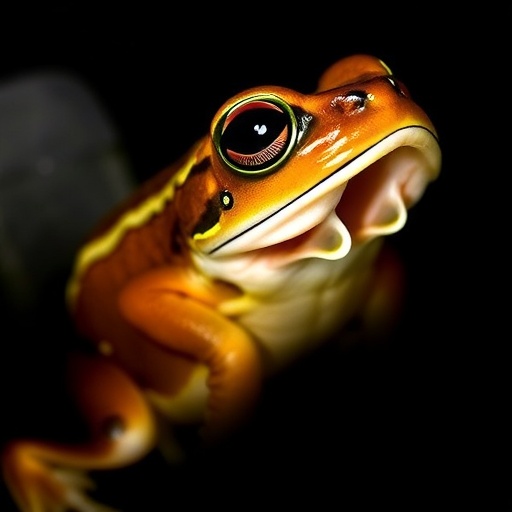In recent research that leverages advanced morphological techniques, the buccopharyngeal structures of tadpoles belonging to the Sphaenorhynchini tribe have been meticulously examined. This study, conducted by leading experts in herpetology, provides invaluable insights into the anatomical adaptations of these aquatic larvae. As the first comprehensive analysis of its kind, it sets the stage for deeper understanding of evolutionary patterns and ecological niches occupied by various amphibian species.
The graduating class of the Sphaenorhynchini group showcases a wide array of adaptations that facilitate their survival in diversified environments. The varied buccopharyngeal morphology among tadpoles serves not only as a point of evolutionary significance but also highlights the role of environmental pressures in shaping anatomical features. This research meticulously documented the adaptations that have evolved over time, influenced by both hierarchies of habitat and available food sources.
The tactical approach used in this comparative study combines both qualitative and quantitative analyses. Researchers employed a combination of imaging techniques and traditional dissection, allowing for a precise examination of the soft tissues involved in feeding mechanisms. The insights gained from this dual methodology elucidate the functional implications of buccopharyngeal morphology, which is critical for the feeding ecology of tadpoles.
One of the most striking observations made during the research was the variation in buccopharyngeal features that correlate with differing diets. In species where filter-feeding is predominant, the morphological adaptations align seamlessly with the need for efficient particle capture. Meanwhile, those that consume larger prey exhibit stronger jaw structures and more complex licking mechanisms. Each adaptation tells a story of the evolutionary pressures that have shaped these species to meet their dietary demands.
Notably, this research also paves the way for future studies examining how these structures may influence the success rates of species in rapidly changing environments. Scientists suggest that as climate change continues to alter habitats, the capacity of these tadpoles to adapt morphologically could play a pivotal role in determining their survival rates. This emphasizes the relevance of understanding morphological traits not only from a taxonomic perspective but also within the context of environmental adaptability.
The findings have implications that extend beyond the scope of just amphibian biology. By marking the first documentation of these specific morphological traits in Sphaenorhynchini tadpoles, the research holds potential for comparative studies across different taxonomic groups. Evolutionary biologists may draw parallels to other amphibians, deepening our understanding of vertebrate morphology and its evolutionary significance.
In terms of ecological studies, the research findings suggest that buccopharyngeal morphology may serve as an indicator of ecological health. Understanding the variations and functions of these structures could assist in monitoring environments where tadpoles inhabit, acting as bioindicators for ecosystem integrity. This kind of biodiverse insight is paramount in conservation strategies aimed at protecting amphibian populations amidst increasing habitat destruction.
Peer reviews of this study assert that the data provide a robust model that could inform conservation biologists and ecologists working in amphibian habitats. With amphibians being one of the most endangered groups of vertebrates, further investigations into how morphology influences food intake and predator avoidance strategies could yield significant conservation strategies.
As the study advances through peer review and eventual publication, it acts as a beacon of hope for understanding the complexities of amphibian life cycles. The intricate relationship between form and function in these young amphibians is slowly unraveling, revealing the importance of base-level species in ensuring balanced ecosystems. It fosters appreciation for their evolutionary journey and highlights the necessity to protect these fragile beings.
Promoting awareness and understanding of such intricate biological studies can ultimately aid in generating public interest in amphibian conservation. By conveying the complexities of tadpole morphology and its implications for survival strategies, researchers hope to foster a more informed readership concerned with biodiversity preservation.
This foundational research will not only captivate students within biological sciences but also ignite discussions in the broader scientific community. The intricate balance of morphology, ecology, and evolution presents a captivating narrative that transcends traditional research boundaries.
Moving forward, collaborative studies that underscore the interaction between anatomical adaptations and environmental shifts will be essential. Bridging gaps between morphological research and conservation efforts will be key. As this narrative unfolds, the shared responsibilities of scientists, policymakers, and the public will determine the future sustainability of amphibian populations globally.
In conclusion, the comparative buccopharyngeal morphology of Sphaenorhynchini tadpoles provides essential insights into amphibian adaptation strategies. This study not only contributes to the academic literature but also serves as a reminder of the fragility of these biological systems. As research continues to evolve, the commitment to understanding and conserving amphibians remains paramount for the health of our planet’s ecosystems.
Subject of Research: Morphological adaptations of Sphaenorhynchini tadpoles
Article Title: Comparative buccopharyngeal morphology of tadpoles of Sphaenorhynchini (Anura: Hylidae: Hylinae).
Article References:
Dias, P.H.d.S., Marcondes, B.C., Campos, Y.P.P. et al. Comparative buccopharyngeal morphology of tadpoles of Sphaenorhynchini (Anura: Hylidae: Hylinae).
Sci Nat 112, 62 (2025). https://doi.org/10.1007/s00114-025-02009-8
Image Credits: AI Generated
DOI: https://doi.org/10.1007/s00114-025-02009-8
Keywords: Tadpole morphology, Sphaenorhynchini, buccopharyngeal structure, evolutionary adaptation, ecological implications.




